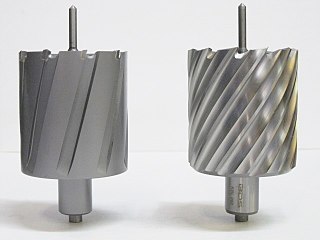 W
WAn annular cutter is form of core drill used to create holes in metal. An annular cutter cuts only a groove at the periphery of the hole and leaves a solid core or slug at the center.
 W
WAn aquatic weed harvester, also known as a water mower, mowing boat and weed cutting boat, is an aquatic machine specifically designed for inland watercourse management to cut and harvest underwater weeds, reeds and other aquatic plant life. The action of removing aquatic plant life in such a manner has been referred to as "aquatic harvesting".
 W
WAn averruncator is a form of long shears used in arboriculture for averruncating or pruning off the higher branches of trees, etc.
 W
WA billhook or bill hook is a versatile cutting tool used widely in agriculture and forestry for cutting woody material such as shrubs, small trees and branches and is distinct from the sickle. It was commonly used in Europe with an important variety of traditional local patterns. Elsewhere, it was also developed locally such as in the Indian subcontinent, or introduced regionally as in the Americas, South Africa and Oceania by European settlers.
 W
WAn annular cutter is form of core drill used to create holes in metal. An annular cutter cuts only a groove at the periphery of the hole and leaves a solid core or slug at the center.
 W
WA brushcutter is a powered garden or agricultural tool used to trim weeds, small trees, and other foliage not accessible by a lawn mower or rotary mower. Various blades or trimmer heads can be attached to the machine for specific applications.
 W
WA cigar cutter is a mechanical device designed to cut one end off a cigar so that it may be properly smoked. Although some cigars are cut on both ends, or twirled at both ends, the vast majority come with one straight cut end and one end in a "cap" which must be cut off for the cigar to be smoked. Most quality handmade cigars, regardless of shape, will have a cap which is one or more small pieces of a wrapper pasted onto one end of the cigar with either a natural tobacco paste or with a mixture of flour and water. The cap end of a cigar is the rounded end without the tobacco exposed, and this is the end one should always cut. The cap may be cut with a knife or bitten off, but if the cap is cut jaggedly or without care, the end of the cigar will not burn evenly and smokeable tobacco will be lost.
 W
WA diamond grinding cup wheel is a metal-bonded diamond tool with diamond segments welded or cold-pressed on a steel wheel body, which usually looks like a cup. Diamond grinding cup wheels are usually mounted on concrete grinders to grind abrasive building materials like concrete, granite and marble.
 W
WA diamond tool is a cutting tool with diamond grains fixed on the functional parts of the tool via a bonding material or another method. As diamond is a superhard material, diamond tools have many advantages as compared with tools made with common abrasives such as corundum and silicon carbide.
 W
WThe electric shaver is a razor with a rotating or oscillating blade. The electric shaver usually does not require the use of shaving cream, soap, or water. The razor may be powered by a small DC motor, which is either powered by batteries or mains electricity. Many modern ones are powered using rechargeable batteries. Alternatively, an electro-mechanical oscillator driven by an AC-energized solenoid may be used. Some very early mechanical shavers had no electric motor and had to be powered by hand, for example by pulling a cord to drive a flywheel.
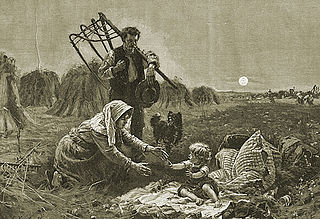 W
WA grain cradle or cradle, is a modification to a standard scythe to keep the cut grain stems aligned. The cradle scythe has an additional arrangement of fingers attached to the snaith to catch the cut grain so that it can be cleanly laid down in a row with the grain heads aligned for collection and efficient threshing.
 W
WA hair clipper is a specialised implement used to cut human head hair. They work on the same principle as scissors, but are distinct from scissors themselves and razors. Similar but heavier-duty implements are used to shear sheep, but are called handpieces or machine shears.
 W
WA hay knife is an agricultural hand tool: a long-bladed knife which may have large rounded serrations on the edge, or a smooth edge used for sawing off sections at the end of a, stack or compact pile of hayor silage. In the England hay knives may have smooth edges. It was needed due to loose hay / silage being compacted in a stack. To remove it a hay knife is used to make a vertical cut so that sections can be removed easily as the intertwined stalks have been cut. The offset handle allows the user to work down a face. Once one section has been removed the worker starts again at the top creating another section to be removed
 W
WA jackhammer is a pneumatic or electro-mechanical tool that combines a hammer directly with a chisel. It was invented by William Mcreavy, who then sold the patent to Charles Brady King. Hand-held jackhammers are generally powered by compressed air, but some are also powered by electric motors. Larger jackhammers, such as rig-mounted hammers used on construction machinery, are usually hydraulically powered. Jackhammers are typically used to break up rock, pavement, and concrete.
 W
WThe Jamshidi needle is a trephine needle for performing bone marrow biopsy, whereby a cylindrical sample of tissue, a core biopsy specimen, is obtained. It is a cylindrical needle with a tapered cutting tip. The tapered end reduces the potential of crush artifact. It is the most commonly used needle for performing bone marrow biopsies. The device is named for its inventor Khosrow Jamshidi who is an Iranian physician.
 W
WA laminate trimmer is a small version of a wood router, normally used to trim laminate such as Formica. It generally has a 1/4-inch collet. Typical laminate trimmers spin their bits at up to 30,000 RPM. Some models provide variable speed control. Manufacturers of note include Dewalt, Ryobi, Porter Cable, Ridgid, Makita and RotoZip (Bosch)
 W
WA lawn mower is a machine utilizing one or more revolving blades to cut a grass surface to an even height. The height of the cut grass may be fixed by the design of the mower, but generally is adjustable by the operator, typically by a single master lever, or by a lever or nut and bolt on each of the machine's wheels. The blades may be powered by manual force, with wheels mechanically connected to the cutting blades so that when the mower is pushed forward, the blades spin, or the machine may have a battery-powered or plug-in electric motor. The most common self-contained power source for lawn mowers is a small internal combustion engine. Smaller mowers often lack any form of propulsion, requiring human power to move over a surface; "walk-behind" mowers are self-propelled, requiring a human only to walk behind and guide them. Larger lawn mowers are usually either self-propelled "walk-behind" types, or more often, are "ride-on" mowers, equipped so the operator can ride on the mower and control it. A robotic lawn mower is designed to operate either entirely on its own, or less commonly by an operator by remote control.
 W
WA nail clipper is a hand tool used to trim fingernails, toenails and hangnails.
 W
WA nibbler, or nibblers, is a tool for cutting sheet metal with minimal distortion. One type operates much like a punch and die, with a blade that moves in a linear fashion against a fixed die, removing small bits of metal and leaving a kerf approximately 6 mm wide. Another type operates similar to tin snips, but shears the sheet along two parallel tracks 3–6 mm apart, rolling up the waste in a tight spiral as it cuts. Nibblers may be manual or powered.
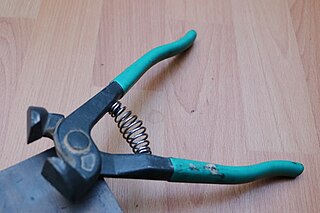 W
WA nipper or tile nipper is a tool used to "nip" or remove small amounts of a hard material, such as pieces of a tile which needs to be fitted around an odd or irregular shape.
 W
WPincers are a hand tool used in many situations where a mechanical advantage is required to pinch, cut or pull an object. Pincers are first-class levers, but differ from pliers in that the concentration of force is either to a point, or to an edge perpendicular to the length of the tool. This allows pincers to be brought close to a surface, which is often required when working with nails.
 W
WA pipecutter is a type of tool used by plumbers to cut pipe. Besides producing a clean cut, the tool is often a faster, cleaner, and more convenient way of cutting pipe than using a hacksaw, although this depends on the metal of the pipe.
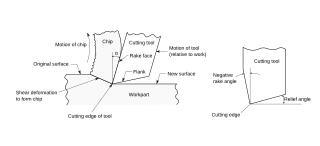 W
WRake angle is a parameter used in various cutting and machining processes, describing the angle of the cutting face relative to the work. There are three types of rake angles: positive, zero or neutral, and negative.Positive rake: A tool has a positive rake when the face of the cutting tool slopes away from the cutting edge at inner side. Zero rake: A tool has a zero rake when the face of the cutting tool is perpendicular to the cutting edge at inner side. Negative rake: A tool has a negative rake angle when the face of the cutting tool slopes away from the cutting edge at outer side.
 W
WA razor is a bladed tool primarily used in the removal of body hair through the act of shaving. Kinds of razors include straight razors, safety razors, disposable razors, and electric razors.
 W
WA rotary cutter is a tool generally used by quilters to cut fabric. It consists of a handle with a circular blade that rotates, thus the tool's name. Rotary cutter blades are very sharp, can be resharpened, and are available in different sizes: usually smaller blades are used to cut small curves, while larger blades are used to cut to straight lines and broad curves. Several layers of fabric can be cut simultaneously with a sharp (fresh) blade, making it easier to cut out patchwork pieces of the same shape and size than with scissors. Quilters use rotary cutters with specially designed templates and rulers made of approximately 1/8-inch thick clear or color-tinted plastic.
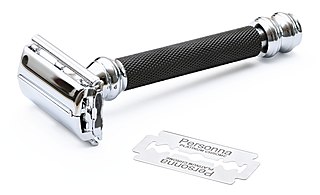 W
WA safety razor is a shaving implement with a protective device positioned between the edge of the blade and the skin. The initial purpose of these protective devices was to reduce the level of skill needed for injury-free shaving, thereby reducing the reliance on professional barbers.
 W
WScissors are hand-operated shearing tools. A pair of scissors consists of a pair of metal blades pivoted so that the sharpened edges slide against each other when the handles (bows) opposite to the pivot are closed. Scissors are used for cutting various thin materials, such as paper, cardboard, metal foil, cloth, rope, and wire. A large variety of scissors and shears all exist for specialized purposes. Hair-cutting shears and kitchen shears are functionally equivalent to scissors, but the larger implements tend to be called shears. Hair-cutting shears have specific blade angles ideal for cutting hair. Using the incorrect type of scissors to cut hair will result in increased damage or split ends, or both, by breaking the hair. Kitchen shears, also known as kitchen scissors, are intended for cutting and trimming foods such as meats.
 W
WA scythe is an agricultural hand tool for mowing grass or reaping crops. It has largely been replaced by horse-drawn and then tractor machinery, but is still used in some areas of Europe and Asia.
 W
WSerration is a saw-like appearance or a row of sharp or tooth-like projections. A serrated cutting edge has many small points of contact with the material being cut. By having less contact area than a smooth blade or other edge, the applied pressure at each point of contact is greater and the points of contact are at a sharper angle to the material being cut. This causes a cutting action that involves many small splits in the surface of the material being cut, which cumulatively serve to cut the material along the line of the blade.
 W
WA sickle, bagging hook or reaping-hook is a single-handed agricultural tool designed with variously curved blades and typically used for harvesting, or reaping, grain crops or cutting succulent forage chiefly for feeding livestock, either freshly cut or dried as hay. Falx was a synonym but was later used to mean any of a number of tools that had a curved blade that was sharp on the inside edge such as a scythe.
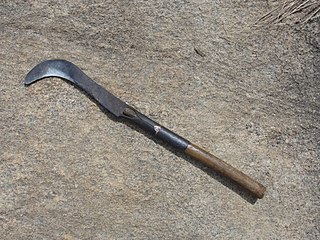 W
WA slasher is an implement with a long sharp blade used to clear scrub. Its long handle, and the open face of its blade, lends it to use for clearing thin and dense low-lying bush or scrub where an axe would be too clumsy. It is similar to a billhook, but with a longer handle.
 W
WA sling blade or kaiser blade is a heavy, hooked, steel blade at the end of a 40-inch (100 cm) handle that is usually made of hickory wood. The blade is double-edged, and both sides are usually kept sharp. It is used to cut brush, briar, and undergrowth. Other common names for the tool are ditch bank blade, briar axe, and surveyor's brush axe. On the East Coast of the United States some farmers call it a bush axe. The Plover, Wisc., dialect refers to it as a ditch witch. Also historically used as a wildland firefighting tool to cut fireline, known as a brush hook. It is also sometimes referred to as a bush hook in south eastern North Carolina. Its use in wildland fire has been substantially superseded by the chainsaw.
 W
WA snap table is a device used to shear concealed-fastener metal roofing panels including snap-lock and mechanically-seamed profiles. It is a tool employed by metal roofing contractors in the field or by metal companies in a shop setting. It works by removing a notch of each rib, slitting the panel in half between the removed notches and rolling the pan over for an eave or valley hem.
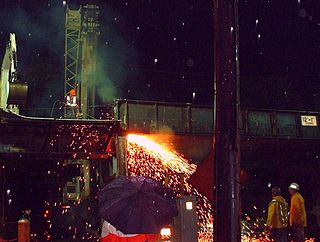 W
WA thermal lance, thermic lance, oxygen lance, or burning bar is a tool that heats and melts steel in the presence of pressurized oxygen to create very high temperatures for cutting. It consists of a long steel tube packed with alloy steel rods, sometimes mixed with aluminium rods to increase the heat output. One end of the tube is placed in a holder and oxygen is fed through the tube.
 W
WA tipped tool is any cutting tool in which the cutting edge consists of a separate piece of material that is brazed, welded, or clamped onto a body made of another material. In the types in which the cutter portion is an indexable part clamped by a screw, the cutters are called inserts. Tipped tools allow each part of the tool, the shank and the cutter(s), to be made of the material with the best properties for its job. Common materials for the cutters include cemented carbide, polycrystalline diamond, and cubic boron nitride. Tools that are commonly tipped include milling cutters, tool bits, router bits, and saw blades.
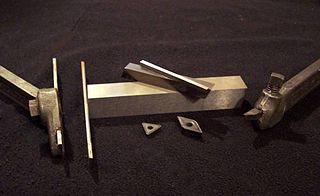 W
WA tool bit is a non-rotary cutting tool used in metal lathes, shapers, and planers. Such cutters are also often referred to by the set-phrase name of single-point cutting tool, as distinguished from other cutting tools such as a saw or water jet cutter. The cutting edge is ground to suit a particular machining operation and may be resharpened or reshaped as needed. The ground tool bit is held rigidly by a tool holder while it is cutting.